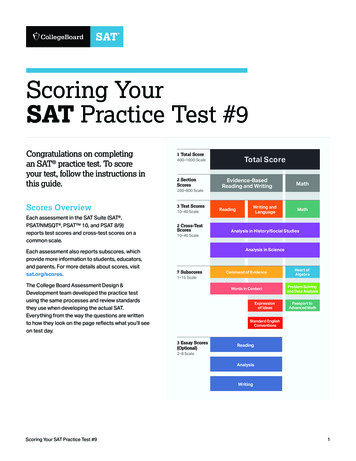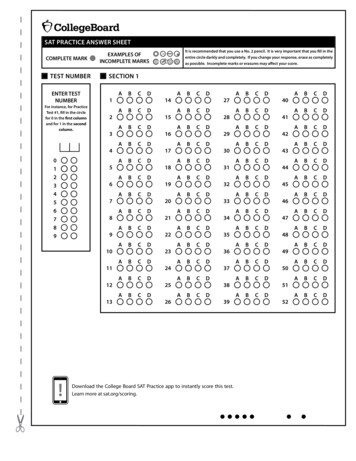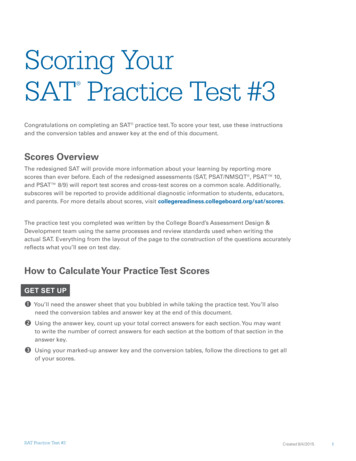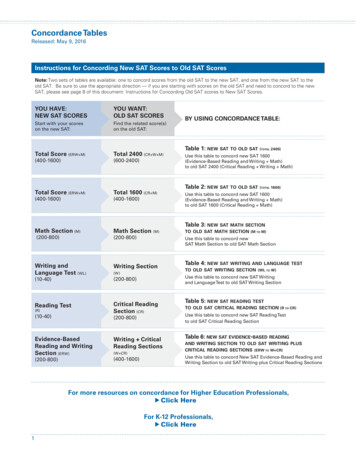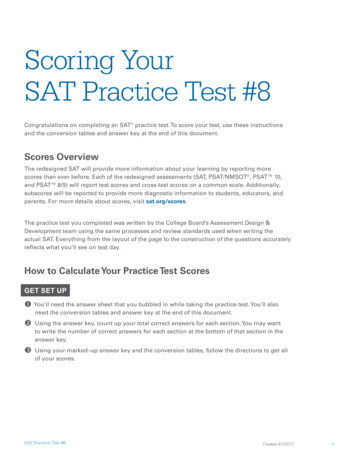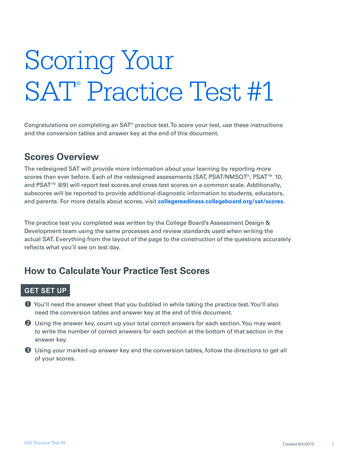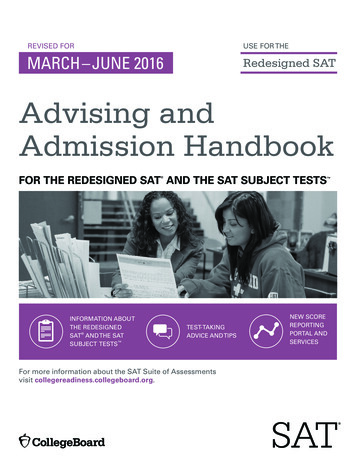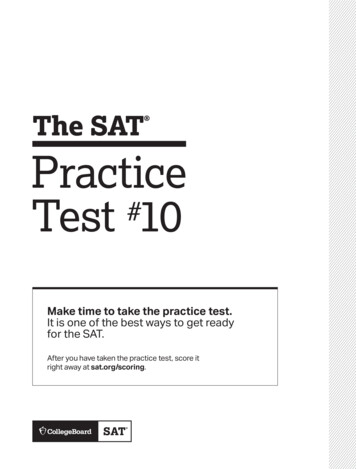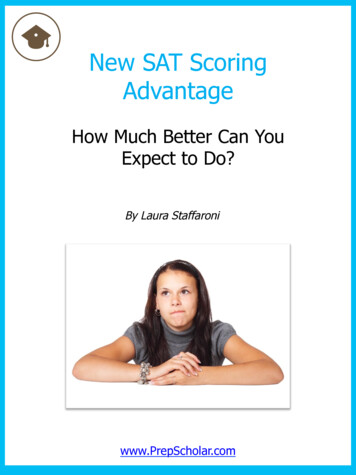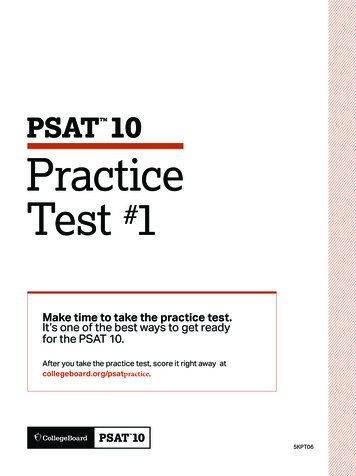
Transcription
PSAT 10 Practice#Test 1Make time to take the practice test.It’s one of the best ways to get readyfor the PSAT 10.After you take the practice test, score it right away atcollegeboard.org/psatpractice.5KPT06
Take the Practice Test Get Credit for All You KnowTake the Practice TestTake the practice test on the following pages tobecome familiar with the kinds of questions on thePSAT 10. The test you take in school will containthe same four sections as this practice test: (1) aReading Test, (2) a Writing and Language Test, (3) aportion of the Math Test on which a calculator is notallowed, and (4) a portion of the Math Test on whicha calculator is allowed.NOTE: This is Practice Test #1. For Practice Test #2,as well as practice tests in MP3 audio and otherformats, go to collegeboard.org/psatpractice. Youcan also call 212-713-8333 to request a practice testin specific formats.Set aside about 3 hours to take the entire test (thisincludes two breaks), and use the practice answersheet on pages 3–6. Have your calculator availableonly for the Math Test – Calculator section. Afterthe test, check your answers to see how you scored.Get Credit for All You Know Use a No. 2 pencil. See “Marking Answers” below for instructionson marking your answer sheet.STANDARD TIMINGReading Test:60 minutesWriting and Language Test: 35 minutesSCORINGEach correct answer:Wrong/blank answers:One pointNo points lostTest-Taking StrategiesTry these out when you take the practice test: Focus on easy questions first. You receive onepoint for each correct answer, no matter howhard or easy the question is. Work steadily. Use a watch to help with pacing.Don’t waste time on a question that is hard foryou. If you cannot answer it, mark it in your testbook and go on. Go back to it later if there is time. It’s okay to guess (see below). Mark your answers in the correct row on theanswer sheet. Be especially careful if you skipquestions. For Math Test – No Calculator questions 14–17and Math Test – Calculator questions 28–31,first write your answer in the boxes above thebubbles, and then grid your answer accuratelyand as completely as the grid will accommodate.If you mark incorrect bubbles, the answer willbe scored as incorrect, even if the right answeris given in the boxes. Double-check your gridsto ensure that you haven’t marked more thanone bubble in the same column.You don’t have to get every question right. Youcan do well even if you answer some questionsincorrectly.Math Test – No Calculator:Math Test – Calculator:25 minutes45 minutesGUESSINGThere is no penalty for wrong answers, so itmakes sense to give the best answer you can toevery question, even if it is just your best guess.MARKING ANSWERSMake sure each mark is dark and completely fills the bubble. If you erase, do so completely. You may usethe test book for scratch work, but for the actual test you will not receive credit for anything you write there.CHECKING ANSWERSWhen you take the test, you may check yourbefore time is called, but you may not turn toany other section.2PSAT 10Practice Test #1For information on how toscore your practice test, goto: collegeboard.org/psatpractice
Priceact
11Reading Test60 M I NU TES, 4 7 QUESTIONSTurn to Section 1 of your answer sheet to answer the questions in this section.DIRECTIONSEach passage or pair of passages below is followed by a number of questions. After readingeach passage or pair, choose the best answer to each question based on what is stated orimplied in the passage or passages and in any accompanying graphics (such as a table orgraph).This passage is adapted from Jane Austen, Emma, originallypublished in 1815.Line510152025Emma Woodhouse, handsome, clever, and rich,with a comfortable home and happy disposition,seemed to unite some of the best blessings ofexistence; and had lived nearly twenty-one years inthe world with very little to distress or vex her.She was the youngest of the two daughters of amost affectionate, indulgent father, and had, inconsequence of her sister’s marriage, been mistress ofhis house from a very early period. Her mother haddied too long ago for her to have more than anindistinct remembrance of her caresses, and herplace had been supplied by an excellent woman asgoverness, who had fallen little short of a mother inaffection.Sixteen years had Miss Taylor been inMr. Woodhouse’s family, less as a governess than afriend, very fond of both daughters, but particularlyof Emma. Between them it was more the intimacy ofsisters. Even before Miss Taylor had ceased to holdthe nominal office of governess, the mildness of hertemper had hardly allowed her to impose anyrestraint; and the shadow of authority being nowlong passed away, they had been living together asfriend and friend very mutually attached, and Emmadoing just what she liked; highly esteemingMiss Taylor’s judgment, but directed chiefly byher own.Unauthorized copying or reuse of any part of this page is illegal.Questions 1-9 are based on the following passage.7230354045505560The real evils indeed of Emma’s situation were thepower of having rather too much her own way, and adisposition to think a little too well of herself; thesewere the disadvantages which threatened alloy to hermany enjoyments. The danger, however, was atpresent so unperceived, that they did not by anymeans rank as misfortunes with her.Sorrow came—a gentle sorrow—but not atall in the shape of any disagreeableconsciousness.—Miss Taylor married. It wasMiss Taylor’s loss which first brought grief. It was onthe wedding-day of this beloved friend that Emmafirst sat in mournful thought of any continuance.The wedding over and the bride-people gone, herfather and herself were left to dine together, with noprospect of a third to cheer a long evening. Herfather composed himself to sleep after dinner, asusual, and she had then only to sit and think of whatshe had lost.The event had every promise of happiness for herfriend. Mr. Weston was a man of unexceptionablecharacter, easy fortune, suitable age and pleasantmanners; and there was some satisfaction inconsidering with what self-denying, generousfriendship she had always wished and promoted thematch; but it was a black morning’s work for her.The want of Miss Taylor would be felt every hour ofevery day. She recalled her past kindness—thekindness, the affection of sixteen years—how she hadtaught and how she had played with her from fiveyears old—how she had devoted all her powers toattach and amuse her in health—and how nursed herthrough the various illnesses of childhood. A largeCO N T I N U E
17075808590* a person in weak health who is overly concerned with his or herailments1The main purpose of the passage is toA) describe a main character and a significantchange in her life.B) provide an overview of a family and a nearbyneighbor.C) discuss some regrettable personality flaws in amain character.D) explain the relationship between a maincharacter and her father.Unauthorized copying or reuse of any part of this page is illegal.65debt of gratitude was owing here; but the intercourseof the last seven years, the equal footing and perfectunreserve which had soon followed Isabella’smarriage on their being left to each other, was yet adearer, tenderer recollection. It had been a friend andcompanion such as few possessed, intelligent,well-informed, useful, gentle, knowing all the ways ofthe family, interested in all its concerns, andpeculiarly interested in herself, in every pleasure,every scheme of her’s;—one to whom she couldspeak every thought as it arose, and who had such anaffection for her as could never find fault.How was she to bear the change?—It was true thather friend was going only half a mile from them; butEmma was aware that great must be the differencebetween a Mrs. Weston only half a mile from them,and a Miss Taylor in the house; and with all heradvantages, natural and domestic, she was now ingreat danger of suffering from intellectual solitude.She dearly loved her father, but he was nocompanion for her. He could not meet her inconversation, rational or playful.The evil of the actual disparity in their ages (andMr. Woodhouse had not married early) was muchincreased by his constitution and habits; for havingbeen a valetudinarian* all his life, without activity ofmind or body, he was a much older man in waysthan in years; and though everywhere beloved for thefriendliness of his heart and his amiable temper, histalents could not have recommended him atany time.1382Which choice best summarizes the firsttwo paragraphs of the passage (lines 1-14)?A) Even though a character loses a parent at anearly age, she is happily raised in a loving home.B) An affectionate governess helps a character toovercome the loss of her mother, despite theindifference of her father.C) Largely as a result of her father’s wealth andaffection, a character leads a contented life.D) A character has a generally comfortable andfulfilling life, but then she must recover fromlosing her mother.3The narrator indicates that the particular nature ofEmma’s upbringing resulted in her beingA) despondent.B) self-satisfied.C) friendless.D) inconsiderate.4Which choice provides the best evidence for theanswer to the previous question?A) Lines 1-5 (“Emma . . . her”)B) Lines 9-14 (“Her . . . affection”)C) Lines 28-32 (“The real . . . enjoyments”)D) Lines 32-34 (“The danger . . . her”)5As used in line 26, “directed” most nearly meansA) trained.B) aimed.C) guided.D) addressed.CO NTI N U E
1As used in line 54, “want” most nearly meansA) desire.B) lack.C) requirement.D) request.7It can most reasonably be inferred that afterMiss Taylor married, she hadA) less patience with Mr. Woodhouse.B) fewer interactions with Emma.C) more close friends than Emma.D) an increased appreciation for Emma.8Which choice provides the best evidence for theanswer to the previous question?A) Line 37 (“Miss . . . married”)B) Lines 47-48 (“The event . . . friend”)C) Lines 60-65 (“A large . . . recollection”)D) Lines 73-79 (“How . . . solitude”)9Which situation is most similar to the one describedin lines 83-91 (“The evil . . . time”)?A) A mother and her adult son have distinct tastesin art and music that result in repeated familyarguments.B) The differences between an older and a youngerfriend are magnified because the younger one ismore active and athletic.C) An older and a younger scientist remain closefriends despite the fact that the older one’s workis published more frequently.D) The age difference between a high school studentand a college student becomes a problem eventhough they enjoy the same diversions.Unauthorized copying or reuse of any part of this page is illegal.6194Questions 10-19 are based on the followingpassage and supplementary material.This passage is adapted from Marina Gorbis, The Nature ofthe Future: Dispatches from the Socialstructed World. 2013by Marina Gorbis.Line5101520253035Visitors to the Soviet Union in the 1960s and1970s always marveled at the gap between what theysaw in state stores—shelves empty or filled withthings no one wanted—and what they saw inpeople’s homes: nice furnishings and tables filledwith food. What filled the gap? A vast informaleconomy driven by human relationships, densenetworks of social connections through which peopletraded resources and created value. The Soviet peopledidn’t plot how they would build these networks. Noone was teaching them how to maximize theirconnections the way social marketers eagerly teachus today. Their networks evolved naturally, out ofnecessity; that was the only way to survive.Today, all around the world, we are seeinga new kind of network of relationship-driveneconomics emerging, with individuals joining forcessometimes to fill the gaps left by existinginstitutions—corporations, governments,educational establishments—and sometimes creatingnew products, services, and knowledge that noinstitution is able to provide. Empowered bycomputing and communication technologies thathave been steadily building village-like networks on aglobal scale, we are infusing more and more of oureconomic transactions with social connectedness.The new technologies are inherently social andpersonal. They help us create communities aroundinterests, identities, and common personalchallenges. They allow us to gain direct access to aworldwide community of others. And they takeanonymity out of our economic transactions. We canassess those we don’t know by checking theirreputations as buyers and sellers on eBay or byfollowing their Twitter streams. We can look up theirfriends on Facebook and watch their YouTubevideos. We can easily get people’s advice on where tofind the best shoemaker in Brazil, the bestCO N T I N U E
14550556065programmer in India, and the best apple farmer inour local community. We no longer have to rely onbankers or venture capitalists as the only sources offunding for our ideas. We can raise funds directlyfrom individuals, most of whom we don’t even know,through websites that allow people topost descriptions of their projects and generatedonations, investments, or loans.We are moving away from the dominance of thedepersonalized world of institutional production andcreating a new economy around social connectionsand social rewards—a process I call socialstructing.Others have referred to this model of production associal, commons-based, or peer-to-peer. Not only isthis new social economy bringing with it anunprecedented level of familiarity and connectednessto both our global and our local economic exchanges,but it is also changing every domain of our lives,from finance to education and health. It is rapidlyushering in a vast array of new opportunities for usto pursue our passions, create new types ofbusinesses and charitable organizations, redefine thenature of work, and address a wide range ofproblems that the prevailing formal economy hasneglected, if not caused.Socialstructing is in fact enabling not only a newkind of global economy but a new kind of society, inwhich amplified individuals—individuals.4017075808590empowered with technologies and the collectiveintelligence of others in their social network—cantake on many functions that previously only largeorganizations could perform, often more efficiently,at lower cost or no cost at all, and with much greaterease. Socialstructing is opening up a world of whatmy colleagues Jacques Vallée and Bob Johansendescribe as the world of impossible futures, a worldin which a large software firm can be displaced byweekend software hackers, and rapidly orchestratedsocial movements can bring down governments in amatter of weeks. The changes are exciting andunpredictable. They threaten many establishedinstitutions and offer a wealth of opportunities forindividuals to empower themselves, find rich newconnections, and tap into a fast-evolving set of newresources in everything from health care to educationand science.Much has been written about how technologydistances us from the benefits of face-to-facecommunication and quality social time. I think thoseare important concerns. But while the quality of ourface-to-face interactions is changing, thecountervailing force of socialstructing is connectingus at levels never seen before, opening up newopportunities to create, learn, and share.Digital information createdand shared (zettabytes)The following graph, from a 2011 report from the International Data Corporation, projects trends in digital information use to 2015(E Estimated).Global Digital InformationCreated and Shared, 2005–2015E8642020052007200920112013E2015ENote: 1 zettabyte 1 trillion gigabytesUnauthorized copying or reuse of any part of this page is illegal.5 10CO NTI N U E
1As used in line 10, “plot” most nearly meansA) mark.B) form.C) plan.D) claim.11The references to the shoemaker, the programmer,and the apple farmer in lines 37-40 (“We caneasily . . . community”) primarily serve toA) illustrate the quality of products and services incountries around the world.B) emphasize the broad reach of technologies usedto connect people.C) demonstrate that recommendations made onlineare trustworthy.D) call attention to the limits of the expansion of theglobal economy.12The passage’s discussion of life in the Soviet Union inthe 1960s and 1970s primarily serves toA) introduce the concept of social networking.B) demonstrate that technology has improved socialconnections.C) list differences between the Soviet Union andother countries.D) emphasize the importance of examininghistorical trends.13As used in line 45, “post” most nearly meansA) publish.B) transfer.C) assign.D) denounce.Unauthorized copying or reuse of any part of this page is illegal.10111 614The author indicates that, in comparison toindividuals, traditional organizations havetended to beA) more innovative and less influential.B) larger in size and less subject to regulations.C) less reliable and less interconnected.D) less efficient and more expensive.15Which choice provides the best evidence for theanswer to the previous question?A) Lines 22-26 (“Empowered . . . connectedness”)B) Lines 40-42 (“We no longer . . . ideas”)C) Lines 47-50 (“We are moving . . .socialstructing”)D) Lines 66-72 (“amplified . . . ease”)16The author recognizes counterarguments to theposition she takes in the passage byA) acknowledging the risks and drawbacksassociated with new technologies and socialnetworks.B) admitting that some people spend too muchtime unproductively on the Internet.C) drawing an analogy between conditions todayand conditions in the Soviet Union of the 1960sand 1970s.D) conceding that the drawbacks of socialstructingmay prove over time to outweigh the benefits.17Which choice provides the best evidence for theanswer to the previous question?A) Lines 35-37 (“We can look . . . videos”)B) Lines 74-76 (“a world . . . hackers”)C) Lines 79-84 (“They . . . science”)D) Lines 85-87 (“Much . . . time”)CO NTI N U E
1Which statement best summarizes the informationpresented in the graph?A) Far more people around the world owncomputers and cell phones today than in 2005.B) The number of people sharing digitalinformation has more than tripled since 2005.C) The volume of digital information created andshared has increased tremendously in recentyears.D) The amount of digital information created andshared is likely to be almost 8 zettabytes in 2015.Unauthorized copying or reuse of any part of this page is illegal.1817 1219According to the graph, which statement is trueabout the amount of digital information projected tobe created and shared globally in 2012?A) Growth in digital information creation andsharing was projected to be wildly out ofproportion to growth in 2011 and 2013E.B) The amount of digital information created andshared was projected to begin a new upwardtrend.C) The amount of digital information created andshared was projected to peak.D) The amount of digital information created andshared was projected to pass 2 zettabytes for thefirst time.CO NTI N U E
1Line510152025303540Understanding how hibernators, includingground squirrels, marmots and bears, survive theirlong winter’s naps may one day offer solutions forproblems such as heart disease, osteoporosis andmuscular dystrophy.Nearly everything about the way an animal’s bodyworks changes when it hibernates, and preparationsstart weeks or months in advance. The first order ofbusiness is to fatten up.“Fat is where it’s at for a hibernator,” saysMatthew Andrews, a molecular biologist at theUniversity of Minnesota Duluth who studies 13-linedground squirrels. “You bring your own lunch withyou.” Packing lunch is necessary because the animalsgo on the world’s strictest diet during the winter,surviving entirely off their white fat. “They have theirlast supper in October; they don’t eat again untilMarch,” Andrews says.Bigger fat stores mean a greater chance ofsurviving until spring. “If they go in really chunky,nice and roly-poly, that’s going to be a goodhibernator,” he says.Bears also watch their waistlines expand in themonths before settling in for the season. The brownbears cardiologist Ole Fröbert studies pack on thepounds by chowing down on up to 40 kilograms ofblueberries a day. Such gluttony among humanscould have severe consequences: Obesity isassociated with a greater risk of heart attack anddiabetes, among other ailments.To see how fattening up affects Scandinavianbrown bears, Fröbert and his colleaguesventured into the wilds of Sweden following signalsgiven off by radio transmitters or GPS devices ontagged bears.Bears can be dangerous close-up. Evenhibernating bears can rouse to action quickly, soscientists tracking down bears in the winter use dartsto tranquilize the animals from a distance. Scientistsstudying the bears in the summer tranquilize themfrom a helicopter.Unauthorized copying or reuse of any part of this page is illegal.13845505560657075Once a bear is under the tranquilizer’s influence(which takes about five minutes), the scientists have60 minutes max to get the animal from its den, weighand measure it, draw blood samples and do minorsurgeries to collect fat and other tissues. The bear isreturned to its den by minute 61.Precious materials collected during thishigh-pressure encounter need to be analyzed within24 hours, so the researchers often test for levels ofcholesterol or certain proteins in the blood whileworking in the snow or at a nearby research station.A pilot sometimes flies samples from field sites to alab in Denmark in order to meet the deadline,Fröbert says. Samples such as bones and arteries thatcan’t be collected from live bears come from bearskilled by hunters during the legal hunting season.Recent analyses revealed that Scandinavian brownbears spend the summer with plasma cholesterollevels considered high for humans; those values thenincrease substantially for hibernation, Fröbert andhis colleagues reported. These “very, very fat” bearswith high cholesterol also get zero exercise duringhibernation. Lolling about in the den pinches offblood vessels, contributing to sluggish circulation.“That cocktail would not be advisable in humans,”Fröbert says. It’s a recipe for hardened arteries,putting people at risk for heart attacks and strokes.Even healthy young adult humans can developfatty streaks in their arteries that make the bloodvessels less flexible, but the bears don’t build up suchartery-hardening streaks. “Our bears, they hadnothing,” Fröbert says. It’s not yet clear how thebears keep their arteries flexible, but Fröbert hopes tofind some protective molecule that could stave offhardened arteries in humans as well.541Milligrams/deciliterThis passage is adapted from Tina Hesman Saey, “Lessonsfrom the Torpid.” 2012 by Society for Science & the Public.Questions 20-28 are based on the followingpassage and supplementary material.1Total Plasma Cholesterolin Seven Bears387232maximum desirable level for humanshibernationactiveCO N T I N U E
1The passage is written from the perspective ofsomeone who isA) actively involved in conducting hibernatorresearch.B) a participant in a recent debate in the field ofcardiology.C) knowledgeable about advances in hibernatorresearch.D) an advocate for wildlife preservation.21It is reasonable to conclude that the main goal of thescientists conducting the research described in thepassage is toA) learn how the hibernation patterns of bears andsquirrels differ.B) determine the role that fat plays in hibernation.C) illustrate the important health benefits ofexercise for humans.D) explore possible ways to prevent human diseases.22Which choice provides the best evidence for theanswer to the previous question?A) Lines 1-5 (“Understanding . . . dystrophy”)B) Lines 10-13 (“Fat . . . squirrels”)C) Lines 31-35 (“To . . . bears”)D) Lines 42-46 (“Once . . . tissues”)Unauthorized copying or reuse of any part of this page is illegal.2019 1423What main effect do the quotations by Andrews inlines 10-18 have on the tone of the passage?A) They create a bleak tone, focusing on thedifficulties hibernators face during the winter.B) They create a conversational tone, relatingscientific information in everyday language.C) They create an ominous tone, foreshadowing thedire results of Andrews’s research.D) They create an absurd tone, using images ofanimals acting as if they were human.24As used in line 19, “stores” most nearly meansA) preservatives.B) reserves.C) stacks.D) shelters.25Based on the passage, what is Fröbert’s hypothesisregarding why bears’ arteries do not harden duringhibernation?A) The bears’ increased plasma cholesterol causesthe arteries to be more flexible.B) Sluggish circulation pinches off the blood vesselsrather than hardening the arteries.C) Bears exercise in short, infrequent bursts duringhibernation, which staves off hardened arteries.D) Bears possess a molecule that protects againsthardened arteries.CO NTI N U E
1Which choice provides the best evidence for theanswer to the previous question?A) Lines 19-20 (“Bigger . . . spring”)B) Lines 24-27 (“The brown . . . day”)C) Lines 69-72 (“Even . . . streaks”)D) Lines 73-76 (“It’s . . . well”)27What information discussed in paragraph 10(lines 58-68) is represented by the graph?A) The information in lines 58-62 (“Recent . . .reported”)B) The information in lines 62-64 (“These . . .hibernation”)C) The information in lines 64-65 (“Lolling . . .circulation”)D) The information in lines 67-68 (“It’s . . . strokes”)Unauthorized copying or reuse of any part of this page is illegal.261151028Which statement about the effect of hibernation onthe seven bears is best supported by the graph?A) Only one of the bears did not experience anappreciable change in its total plasma cholesterollevel.B) Only one of the bears experienced a significantincrease in its total plasma cholesterol level.C) All of the bears achieved the desirable plasmacholesterol level for humans.D) The bear with the lowest total plasma cholesterollevel in its active state had the highest totalplasma cholesterol level during hibernation.CO NTI N U E
1This passage is from Andrew Carnegie, "Wealth," originallypublished in 1889. Arriving penniless in Pennsylvania fromScotland in 1848, Carnegie became one of the richestpeople in the United States through the manufacture ofsteel.Line5101520253035The problem of our age is the properadministration of wealth, that the ties of brotherhoodmay still bind together the rich and poor inharmonious relationship. The conditions of humanlife have not only been changed, but revolutionized,within the past few hundred years. In former daysthere was little difference between the dwelling,dress, food, and environment of the chief and thoseof his retainers. . . . The contrast between the palaceof the millionaire and the cottage of the laborer withus to-day measures the change which has come withcivilization. This change, however, is not to bedeplored, but welcomed as highly beneficial. It iswell, nay, essential, for the progress of the race thatthe houses of some should be homes for all that ishighest and best in literature and the arts, and for allthe refinements of civilization, rather than that noneshould be so. Much better this great irregularity thanuniversal squalor. Without wealth there can be noMaecenas.* The “good old times” were not good oldtimes. Neither master nor servant was as wellsituated then as to-day. A relapse to old conditionswould be disastrous to both—not the least so to himwho serves—and would sweep away civilization withit. But whether the chang
PSAT 10. The test you take in school will contain the same four sections as this practice test: (1) a Reading Test, (2) a Writing and Language Test, (3) a portion of the Math Test on which a calculator is not allowed, and (4) a portion of the Math Test on which a calculator is allow

